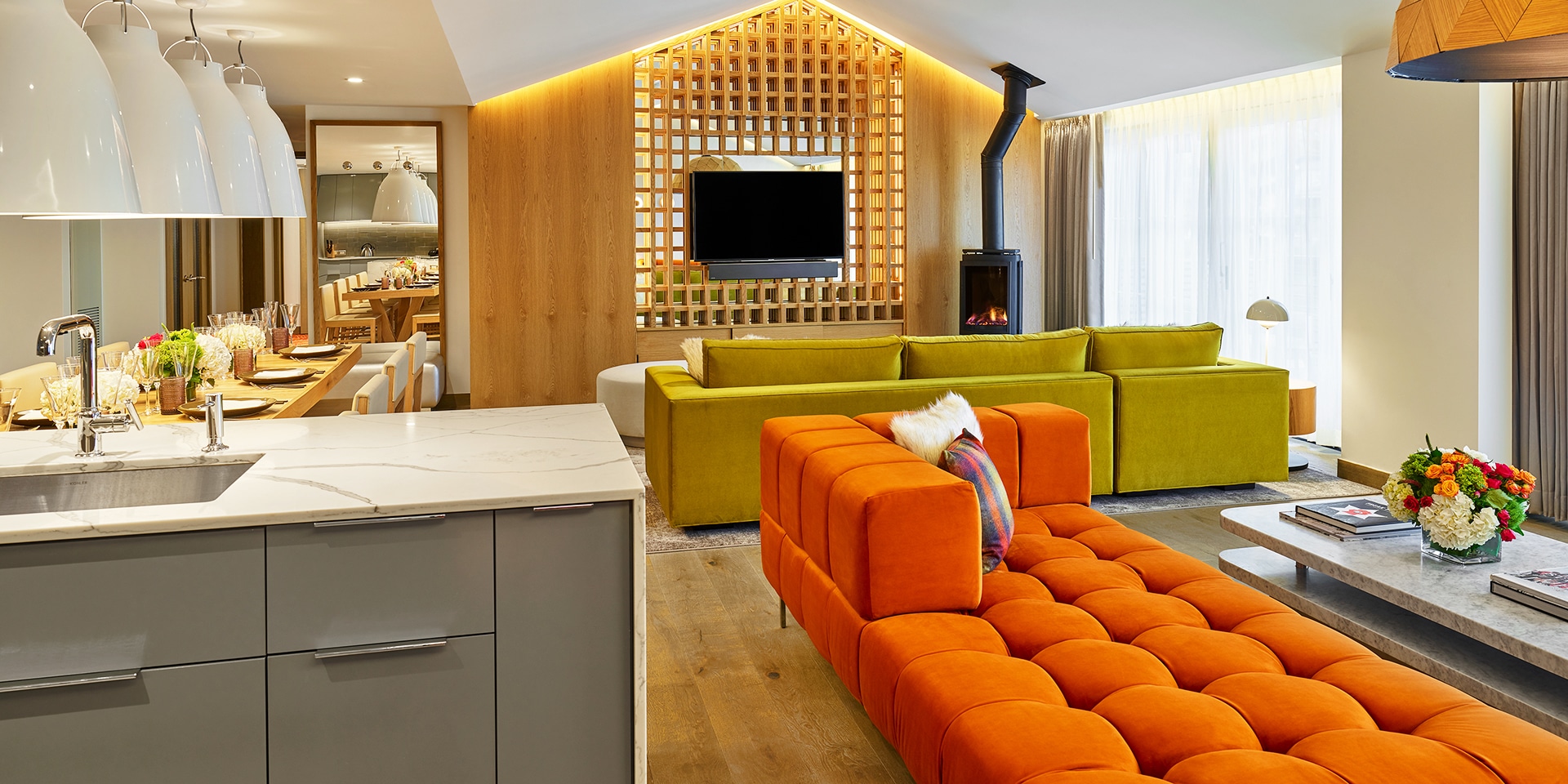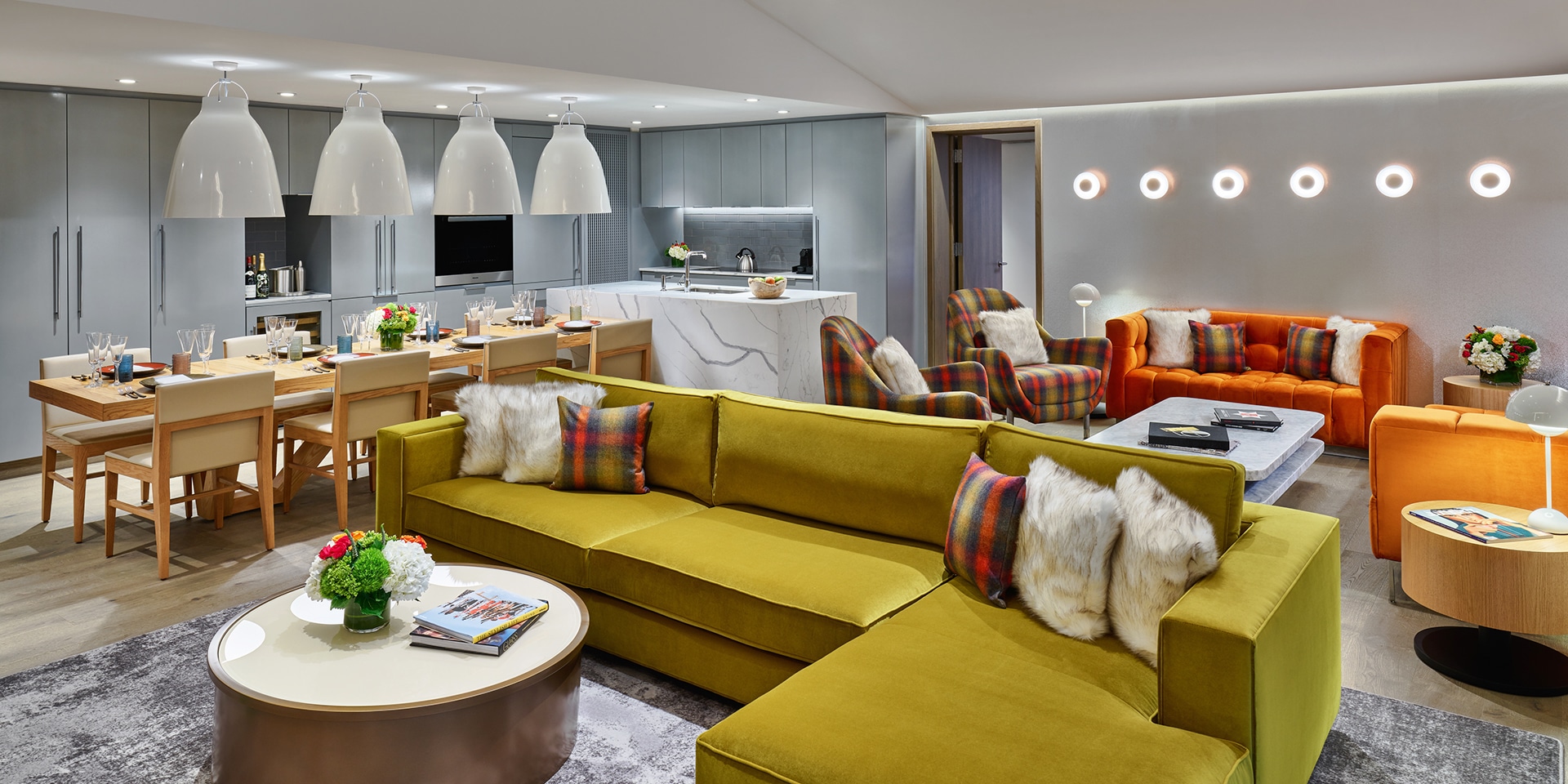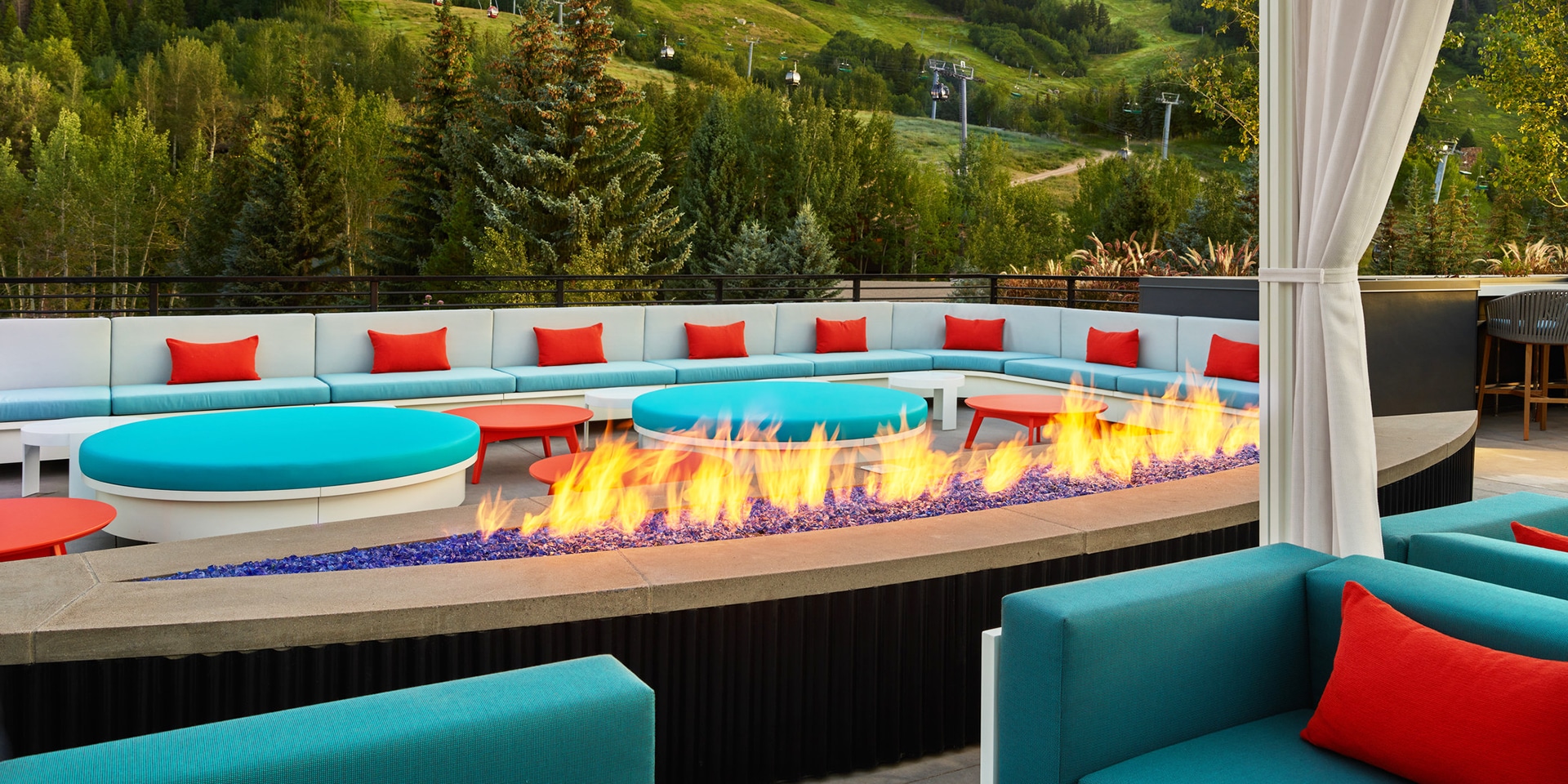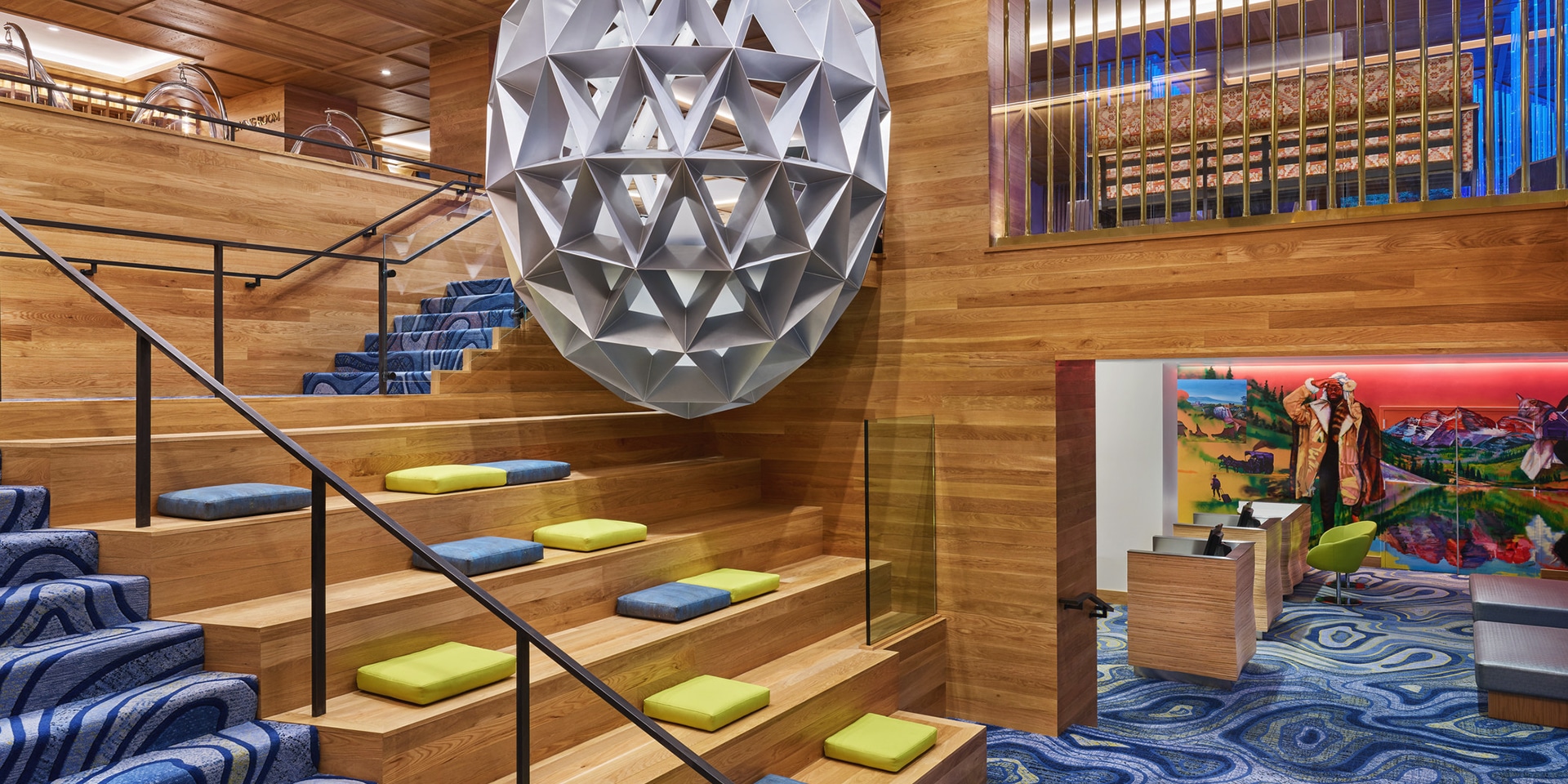Rising from the base of Aspen Mountain, The Sky Residences at W Aspen’s peaked roofs evoke the classic silhouette and style of a European ski chalet but with an up-to-the-minute interpretation, constructed with environmentally sustainable materials and contemporary finishes.
The new property comprises a series of firsts: the first W Hotels ski escape in the United States, the first new hotel to open in Aspen in 25 years, and currently the town’s only public mountainside après-ski venue. Combined, these elements are bound to enliven the local scene. The property includes 88 hotel rooms, 11 shared ownership residences and a variety of public spaces that will attract an energetic clientele.
According to Marriott Global Design Director Martin Ablaza, creative collaborators contemplated historical, physical and social contexts as they determined the storytelling approach that drove design decisions behind The Sky Residences at W Aspen.
“Storytelling allows us to tap into unique insights in the location and bring them to life through unexpected elements, infused with wit and a dash of whimsy,” he said.

History with a Twist
Colorado-based architecture firm Rowland+Broughton envisioned the property in the ski chalet style that is characteristic of the town, incorporating sloped ceilings and level changes throughout the interior, giving each space a cozy, individual style.
“There are three basic elements to a ski chalet,” Ablaza explained. “There’s a sloping roof with overhanging eaves, rustic and compact wooden architecture, and iconic elements of fire and warmth.”
Rowland+Broughton Principal, John Rowland, expands on that idea. “By design, the architectural concept of a modern ski chalet links Aspen’s past, present and future,” says Rowland. “W Aspen contributes to the base of the mountain location with its sloping roofs and natural, high-quality materials. Plus, it’s infused with modern-day detailing that weaves into the fabric and history of town.”
As skiers schuss down from Aspen Mountain toward the ski-in portion of the property, the second-floor Living Room welcomes them with its outdoor mezzanine and dramatic fire pit. “It serves as a beacon,” Ablaza said, “drawing guests in for the afternoon après-ski ritual.”
The design team also turned a keen eye toward Aspen’s colorful history as they developed the property’s public spaces. In fact, part of The Sky Residences at W Aspen’s story tracks back to 1879, when miners established the town and soon discovered a 30-mile-long vein of silver ore. The underground riches drew thousands to seek their fortunes at 8,000 feet of altitude.
The prize treasure, the largest silver nugget ever found, emerged from deep in the Smuggler Mine in 1894. It weighed over 2,000 pounds and consisted of 93 percent pure silver.
Today, the DJ booth in W Aspen, created by New York interior design firm nemaworkshop, evokes this legendary nugget.

“They took the size and scale of the world’s largest silver nugget,” Ablaza said, “and streamlined it and abstracted it to impart that same sense of awe the original silver nugget gave during the mining boom.”
The glittering DJ booth, faceted like a gem, is visible from the driveway, suspended above the stairway/seating area that leads visitors up to the second floor where it gleams at the center of the Living Room.
In the residences and throughout the property, lighting fixtures that recall miners’ headlamps and millwork details patterned after the grid structures used to fortify shafts into the mines also conjure Aspen’s mining history.
To be sure, Aspen was founded for its mining opportunities, and then its world-class skiing gained notice after soldiers stationed there during World War II returned to establish resorts, building two ski lifts that together comprised “the longest chairlift in the world” in 1946.
But Aspen is also well-known for the bohemian and counterculture atmosphere that attracted throngs of revelers in the decadent ’70s, including Jack Nicholson, John Denver and Goldie Hawn. This era earned Aspen its nickname, Glamour Gulch.
“This spirit is evoked throughout the interior of the property,” Ablaza explained. “The blur between something that’s very glamorous and something that’s very rustic creates the aesthetic that’s W’s take on the Aspen experience.”
In W Aspen’s EWOW suite, designed for hosting events and parties, there’s a central fire pit, a hot tub open to the living area and “brass and crystal rods that create a screening element around a bed that’s set on a rotating platform, as a nod to the hedonistic architecture of Aspen’s pleasure palaces of the era,” Ablaza said.
Similarly, the property’s residences also feature banquette seating with velvety textures and furniture, pillows and lighting fixtures with pops of ’70s-inspired color that bring this spirit of playful decadence to their sleek, contemporary interiors. “Some iconic elements carry over to the residences,” Ablaza said, but they were also designed with a little “more restraint … leaving room for interpretation.”

Residents and guests with youthful joie de vivre are also bound to linger on the 8,000-square-foot WET Deck, an all-weather rooftop gathering space with panoramic mountain views, banquette seating, a DJ booth, a hot tub, a heated swimming pool and a bar whose overhang is like a whimsical upside-down model of the mountains’ relief.
Owners of Sky Residences have the privilege of their own balconies and decks and will also have access to a private rooftop lounge, which includes hot tubs, outdoor dining space and grilling areas, according to Ablaza.
Local Art Invigorates Design
The designers behind The Sky Residences at W Aspen also took care to incorporate inspiration from local artists. The graphic artist Thomas W. Benton moved to Aspen in the 1960s, and his art, including posters he created for Hunter S. Thompson’s wacky 1970 candidacy for Pitkin County Sheriff, evoke the style and spirit of the era.
These posters, with their muted color gradation patterns, influenced the palette of the bathrooms on the living room level.
Celebrating “hidden gems of Aspen,” Forte Aspen designed the pillow artwork to highlight the unique history and location of W Aspen in what was historically the “red-light district” during the turn of the century.
Local designer Jenna Holcomb says she was inspired by both Benton, as well as another iconic Aspen artist, Herbert Bayer, when creating the W Aspen bed pillow graphics. “It’s meant to be part of a process of discovery,” says Holcomb. “The back of the pillows show a hand-illustrated trail map of Aspen Mountain which suggests a sketch on a napkin, a modern-day treasure map for adventurous visitors and locals.”
Ablaza also explains how the Rocky Mountains inspired the Hudson River School of landscape painters in the 1800s — in particular, the majestic works of Albert Bierstadt.

“We wanted to see if there were artists out there who could impart their own vision on what Aspen is today through the lens of these historical paintings,” Ablaza said.
The team invited the artist Gaia, originally a street muralist, to create work for W Aspen, and he came up with works that incorporated elements from Bierstadt paintings, as seen, for example, through the camera of a smartphone. Gaia “interprets the local voice through the veil of historical painting … with a youthful and modern take on local culture,” Ablaza said.
Ablaza said designers also embraced the kitschier elements of Rocky Mountain art.
The Bob Ross technique of paint-by-numbers influenced the signage in the corridors, and the location’s former status as a red-light district during the mining era set the mood for 39 Degrees, the destination bar within the complex, “recalling a Victorian bordello palette with crushed velvets and a lot of reds … and the pit seating that’s synonymous with the ’70s.”
Referring to Aspen’s location on the 39th parallel, the 39 Degrees moniker and logo design are also infused with meaning.
“Forte Aspen was inspired by latitude and longitude lines when creating the retro-inspired custom font that makes up the 39 Degrees logo,” says R.J. Gallagher, Jr. “The curved shapes allude to Aspen’s famed silver mine tunnels and the light of a miner’s headlamp. An Instagram-worthy neon sign can serve as the proverbial ‘light at the end of the tunnel.’”
Aspen is known for luxury and recreation, and The Sky Residences at W Aspen evoke the bold spirit that characterized the town’s multiple heydays — and just might foster a new prime.




